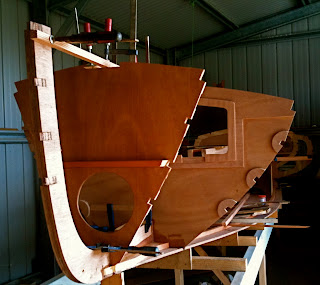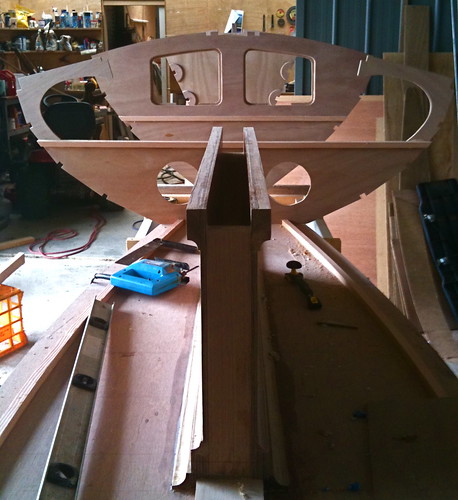 Before the gunwales are fitted, it seems advantageous to do a few jobs and trial fit a few things that will be harder to do later. One of those has been designing and fitting the seat ply. I still had some ply left over from my last build, and while waiting for some new Gaboon for the hull planking, I was determined to use as much of the left-overs as possible. It was close, but it was done. The pic above is of the aft-most sheets before trimming the inner edges for shape. Those edges will also be thickened with doublers to produce a comfortable and serviceable edge. The angled cuts at the corners enable the joints to follow supporting beams, but with the joints at the corners being formed with edges roughly perpendicular to the edge. This makes a nice curve easier and stronger.
Before the gunwales are fitted, it seems advantageous to do a few jobs and trial fit a few things that will be harder to do later. One of those has been designing and fitting the seat ply. I still had some ply left over from my last build, and while waiting for some new Gaboon for the hull planking, I was determined to use as much of the left-overs as possible. It was close, but it was done. The pic above is of the aft-most sheets before trimming the inner edges for shape. Those edges will also be thickened with doublers to produce a comfortable and serviceable edge. The angled cuts at the corners enable the joints to follow supporting beams, but with the joints at the corners being formed with edges roughly perpendicular to the edge. This makes a nice curve easier and stronger. In this pic we have the whole messy puzzle, made up of eight oversized pieces; none of them lying particularly flat, but fitting at the important edges nonetheless. I found it very helpful to have it all laid out like this, to consider the seating ply as one shape or surface. The curves were drawn freehand on one side of the centreline, having established the right minimum overhangs, and then the shapes were cut and transferred from the cut pieces to their opposite pieces.
In this pic we have the whole messy puzzle, made up of eight oversized pieces; none of them lying particularly flat, but fitting at the important edges nonetheless. I found it very helpful to have it all laid out like this, to consider the seating ply as one shape or surface. The curves were drawn freehand on one side of the centreline, having established the right minimum overhangs, and then the shapes were cut and transferred from the cut pieces to their opposite pieces.
Below the shapes are cut and ready for the fitting of the doublers. The sheeting has all been marked for orientation, and will be put aside until the planking is done.
The brace that goes across the top of bulkhead 4, at the front of the centreboard case is temporary. That space will be open, and very useful when complete.


























